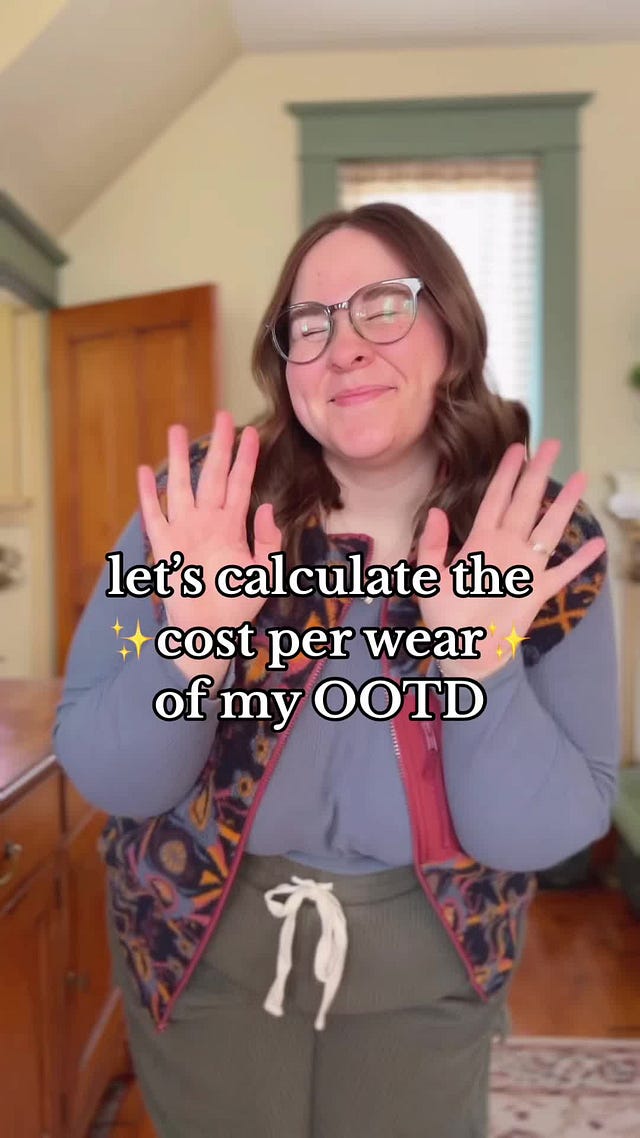Is Cost-Per-Wear as Useful as We Think?
Why the age-old metric might not be the best indicator of value.
If you’ve been interested in fashion for any length of time, then you’re almost certainly familiar with the concept of cost-per-wear. If not, here’s the gist: a pair of pants by The Row might cost $1420, but if you wear them twice a week over the course of five years, they’ll ring in at just under $3.00 per wear. Total bargain, right? The purpose of cost-per-wear is that it purports to help people understand the true value of their clothes and make better decisions when it comes to purchasing new items. Nobody wants to be the stooge who spends $50 on a fast fashion dress they wear only once.
I’ve always conceived of as cost-per-wear as a relatively innocuous concept. It seems like a reasonable way for people to calculate the value of what they own, plus I tend not to concern myself with the mental gymnastics required for other people to spend on clothes. At its best, cost-per-wear is a way to convince people to invest in better quality clothes. At its worst, it’s a psy-op designed by the fashion industry to make people feel more comfortable spending inordinate amounts of money on clothing. Historically I’ve tended to lean towards the former, but I’ve started to rethink the utility of cost-per-wear.
Recently, I was alerted to the existence of a genre of content on TikTok that involves people breaking down the cost-per-wear of the outfit that they’re wearing. Here are some examples:
These videos are infused with a deep sense of earnestness. The creators appear to be genuinely excited about showing off their outfits while appearing slightly nervous about the radical transparency underpinning the format. There’s nothing offputting about the videos themselves; it was the realization that it is possible to calculate the specific cost of an outfit I found deeply unnerving. This sounds obvious but work with me here. Even when the total cost ends up being relatively ‘low’, it still makes me feel physically ill to think about how it technically cost me $40 just to leave the house wearing clothes that I like.
As a relatively frugal person when it comes to everything BUT my clothes, this level of financial specificity makes me want to exclusively start wearing converted pillowcases. The thing is, I’m not entirely convinced that the ‘true value’ of an outfit can be measured numerically alone. What about its emotional resonance? Its sentimental value?
The issue is that I conceive of value differently when it comes to clothing compared to any other category. Of course I think about how often I will wear something before I put down my credit card, but I also know that I’ve miscalculated many times before. Ultimately, there’s no way of knowing exactly how often you’ll wear something until it’s actually situated in your closet. I have bought holy grail items (ahem, tabi boots) that I ended up never wearing because they didn’t actually suit my style. But that stretchy leopard American Apparel catsuit I literally bought as a joke? Yeah, I’ve worn it around five times in just as many months.
Let’s take the single most expensive item in my closet: a black Prada Saffiano bag I purchased for $2K on Vestiare Collective in 2018, when I was under the impression that I couldn’t be taken seriously as a fashion editor without hauling around a designer bag. I estimate I’ve used it between 20 and 40 times in the last six years, which honestly seems pretty low to me. If we’re calculating on the generous end of the spectrum, this bag cost me $50 every time I left the house. And then factoring the cost of the clothing I am wearing on top of that? Sacre bleu!
It’s deeply embarrassing to think about how I am more than likely spending $100 every time I leave the house. Insert cringeworthy joke on the cost of living in Toronto here. But is this enough to make me want to stop spending money on clothes? No, it is not. I buy clothing for joy of wearing it, not for some made-up notion of financial efficacy. The value of an item in my closet is primarily determined by my emotional relationship to it, not how often it gets worn. If I can genuinely say that an article of clothing brings me a modicum of delight, then I would honestly rather not know how much it cost me to wear each time.
Of course I believe in the merits of practicality. I’m a Capricorn, for God’s sake. While we don’t need to abandon the concept of cost-per-wear wholesale, we should expand our conception of what constitutes value at an individual level. For practical people who have trouble convincing themselves to spend money on clothing at all, cost-per-wear makes sense. But for the romantics and the dreamers out there? I think it’s better to embrace that ignorance truly is bliss. If calculating the worth of your wardrobe down to every penny is a worthwhile pursuit, than go forth and flourish! But I’ll be over here, wearing clothes for no other reason than I want to. I highly encourage you to do the same.










Absolutely, thanks for sharing this - I can’t even begin to quantify the emotional value of my wardrobe, a lot of my faves are priceless regardless of their original cost. That also goes for the few pieces of vintage clothes I don’t wear but which I couldn’t bear to leave on the charity shop rack, like the pure wool WWII Wren boat cloak which no one else seemed to want. Will I wear it? Probably not. Does it make my heart skip with its history and quality when I see it hanging there preserved for the future? Every single time.
I no longer buy clothes as I make my own clothes (after many, many years of experience and practice in sewing, of course) and I never kept track of how much I spent on fabric and other supplies. People usually classify those expenses as hobbies but for me it is literally how I clothe myself. My wardrobe is about 99% made by me, underwear and socks aside, and I wouldn't have it any other way.
Anyway, I was having some FOMO late last year as people who sew their clothes were sharing their end-of-year reports on Instagram, akin to the cost-per-wear thing on TikTok, and I started keeping track of the purchases this year. I do not like it!
In my defense, not that I NEED to defend myself, the clothes I make for me are closer in quality to mid to high end ready to wear than to Zara or H&M.
I also do some purely hobby sewing like quilting and historical costuming.
I will not calculate cost-per-wear for shoes or bags because I would probably cry.